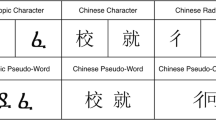Abstract
Preschool children were presented with modified jigsaw puzzles containing 1, 3, 6, 10, and 16 pairs of pieces. Half of the Ss were given 30 sec. to complete each puzzle; half were given 2 min. Both groups exhibited an inverted-U relationship between complexity and preference. As predicted, the 2-min. group exhibited maximal preference for a higher complexity level than did the 30-sec. group. The advantages of tasks as opposed to random stimuli in complexity preference research were discussed.
Similar content being viewed by others
References
ARKES, H. R., & BOYKIN, A. W. 1971. Analysis of complexity preference in Head Start and nursery school children. Perceptual and Motor Skills, 33, 1131–1137.
ATTNEAVE, F. 1957. Physical determinants of the judged complexity of shapes. Journal of Experimental Psychology, 53, 221–227.
BERLYNE, D. 1960. Conflict, arousal, and curiosity. New York: McGraw-Hill.
BERLYNE, D. E. 1967. Arousal and reinforcement. In D. Levine (Ed.), Nebraska Symposium on Motivation. Lincoln: University of Nebraska Press.
BOYKIN, A. W. 1972. Verbally expressed preference and complexity judgments as they relate to levels of performance in a problem-solving situation. Unpublished doctoral dissertation, University of Michigan.
DAY, H. I., & CRAWFORD, G. C. 1971. Developmental changes in attitudes toward complexity. Paper presented at the meeting of the Society for Research on Child Development, Minneapolis, April.
DEMBER, W., & EARL, W. 1957. Analysis of exploratory, manipulatory, and curiosity behavior. Psychological Review, 64, 91–96.
KAMMAN, R. 1966. Verbal complexity and preferences in poetry. Journal of Verbal Learning and Verbal Behavior, 5, 536–540.
MAY, R. 1963. Stimulus selectin in preschool children under conditions of free choice. Perceptual and Motor Skills, 16, 203–206.
McCALL, R. B., & MELSON, W. H. 1970. Complexity, contour and area as determinants of attention in infants. Developmental Psychology, 3, 343–349.
MUNSINGER, H., & KESSEN, W. 1964. Uncertainty, structure, and preference. Psychological Monographs, 78, 1–24.
MUNSINGER, H., & KESSEN, W. 1966a. Stimulus variability, and cognitive change. Psychological Review, 73, 164–178.
MUNSINGER, H., & KESSEN, W. 1966b. Structure, variability, and development. Journal of Experimental Child Psychology, 4, 20–49.
STENSON, H. H. 1966. The physical factor structure of random forms and their judged complexity. Perception and Psychophysics, 1, 303–310.
TAYLOR, W. L. 1954. Application of “cloze” and entropy measures to the study of contextual constraint in samples of continuous prose. Unpublished doctoral dissertation, University of Illinois.
THOMAS, H. 1966. Preferences for random shapes: Ages six through nineteen years. Child Development, 37, 843–859.
THOMAS, H. 1971. Discrepancy hypothesis: Methodological and theoretical considerations. Psychological Review, 78, 249–259.
VANDERPLAS, J. M., & GARVIN, E. A. 1959. Complexity, association value, and practice as factors in shape recognition following paired-associates training. Journal of Experimental Psychology, 57, 155–163.
Author information
Authors and Affiliations
Additional information
We wish to thank Mr. Martinez and the staff of the Washtenaw County, Michigan, Head Start Program for their cooperation.
Rights and permissions
About this article
Cite this article
Boykin, A.W., Arkes, H.R. Processing Time and Complexity Preference in Preschool Children. Psychol Rec 24, 259–265 (1974). https://doi.org/10.1007/BF03394242
Published:
Issue Date:
DOI: https://doi.org/10.1007/BF03394242




